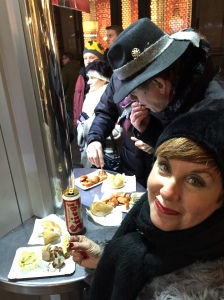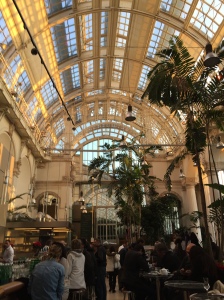For some stupid reason, I’ve always thought I disliked Germanic cuisine. Part of this might be because my German mother-in-law, bless her heart, isn’t big on making meals from scratch, as she readily admits. During my first visit to her house, she served a box of spaetzle (an egg-based dumpling) that looked and smelled just like the formaldehyde-soaked fat bodies of the frogs we dissected in high-school biology. Needless to say, I spent most of the meal trying to hide the rubbery chunks beneath my napkin. Great way to make a fabulous first impression on my future in-laws.

Matthew’s German grandmother, on the other hand, was a truly skilled home cook. While I got to taste only a few of her yummy dishes (mmmm, cabbage rolls!), her food gave me hope that maybe I’d find more to like in Austria. Preferably not Chicago Oktoberfest fare: heavy, gravy-laden gut busters best relieved by a bottle of Tums. And perhaps something beyond the sausage-and-potato-pancake diet that we’d thrived on during last year’s visit to Nürnberg’s Christkindlesmarkt.

However, I’ll be honest and say that we did our fair share of sampling similar street food from the New Year’s stalls erected in Vienna’s plazas. Würstelstands tempted us with delicious Leberkäse, Frankfurters, and Bratwurst dipped in various mustards. And who could resist potato pancakes brushed with garlicky oil? (Quite different from those in Germany.) But our favorite revelation was the variety of puncshes. Far beyond glühwein and glögg, these featured every combination of alcohol imaginable, with some being a close kin to eggnog. Most punsch stands advertised around 20 varieties in all, and believe me, Matthew and I worked hard to ensure that no vendor or flavor felt left out. (We didn’t want to be rude, of course.)

We did eventually make our way into a few more real restaurants, including Gigerl Stadtheuriger. To explain, a heuriger is a wine-garden restaurant that features its own vintages. It serves heurig (meaning “this year’s”) wine until the next year’s vintage comes out on November 11. Think of it as an Austrain eatery that makes its own version of the French beaujolais nouveau (which is released annually on the third Thursday in November — it’s the European version of Thanksgiving.) While most heurigers sit in the middle of vineyards outside the city, Gigerl is located in the heart of Vienna near St. Stephen’s.


The great thing about these restaurants is not only do they make unbelievable wines, but they also offer terrific deli-style meals. Gigerl’s counter laid out such a tempting spread that we ordered two giant tasting plates — one featuring a smattering of every available appetizer and another featuring mostly meat. Go big or go home is our philosophy. And of course, we couldn’t refuse the opportunity to try the traditional dessert of kaiserscharren mit Zwetschkenröster (fluffy pancakes with stewed plums).

After a meal like that, you’d think we’d fast for the rest of the trip. But of course the next day we trotted out to put on the old feedbag once again. This time, we tried Palmenhaus (The Palm House) — basically a botanic conservatory that serves tasty modern cuisine, Austrian style. By this I mean that we savored an incredible celeriac soup and a salad with croutons made of blood sausage coated in fried cheese. Yep, this was our version of a light lunch. So awesome I still dream about it.

But lest you think we didn’t do Vienna’s coffeehouses justice, we did make time (and room in our tummies) for Sacher-Torte at the famous Café Sacher. Actually, we ate at the Sacher Stube — the smoker’s salon next door — which is a great alternative if the line is too long at the café … and if you can manage to avoid inhaling deeply for an hour or so. A friendly waitress dressed in a French maid uniform brought us our torte and shared the story of its creation with us: Prince Metternich (of Napoleonic-war fame) tasked his head chef with creating a new dessert to impress some important guests. The chef fell ill, and his 16-year-old apprentice, Franz Sacher, stepped in to create a now legendary treat — a ganache-coated, chocolate cake layered with apricot jam. Mmmm, good.
Stay tuned for one last Viennese post — this one about the New Year’s Eve Ball at City Hall!





